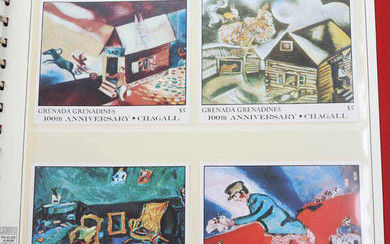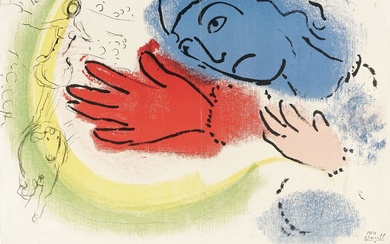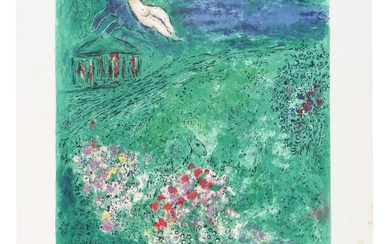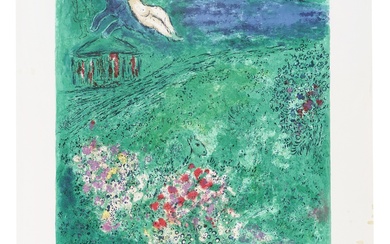MARC CHAGALL (Vitebsk 1887–1985 Saint-Paul-de-Vence)
La révolution. 1939.
Oil on canvas.
With the signature stamp lower centre: Chagall.
28 × 49 cm.
The authenticity of the work has been confirmed by the Comité Marc Chagall, Paris, 9.5.2023.
Provenance:
- Estate of the artist.
- Jean-François Gobbi, Neuchâtel/Geneva.
- Private collection USA.
- Private collection London.
Exhibited:
Nassau 2001/02, Twentieth Century Exiles: Artists Fleeing Hitler's Oppression, Naussau County Museum of Art, November 2001–February 2002.
Chagall first depicted the Russian Revolution of 1917 in a series of oil paintings initiated in 1937 to commemorate the twentieth anniversary of the Revolution. The final work, a large-scale triptych, titled 'Résistance, Résurrection et Libération' was created approximately thirty years later, building on the ideas the artist had developed and refined in smaller oil and paper studies in 1937. In the same year, Pablo Picasso produced his famous 'La Guernica', which he painted as an expression of protest against the destruction of the Spanish Civil War. This work also prompted Chagall to express himself politically through his art.
In 'La Révolution', two worlds confront each other: on the left side, a group of barricade-storming revolutionaries are depicted, raising the red banners of the Bolsheviks and proudly proclaiming the victory of communism. In contrast, the right side shows the free play of human imagination and typical Chagall motifs such as lovers floating above the wooden hut of his native village, animals, musicians and a large, warm, yellow sun. As a unifying element in the centre, a rabbi reads the Torah and a figure of Lenin, acrobatically balancing on one hand, shows the revolutionaries the true path to a world of individuality.
Franz Meyer described the work as follows: 'To interpret the picture one must start from the contrast between the left and right halves. The political revolution, the actual uprising, on the left is balanced on the right by the artistic-human revolution proclaimed by Chagall. Its manifestations are not guns and slogans, but music and love.' (Meyer, 1963, p. 414).
The work presented here is one of the studies that Chagall painted in the earliest phase of 1937.
View it on
Sale price
Estimate
Time, Location
Auction House
La révolution. 1939.
Oil on canvas.
With the signature stamp lower centre: Chagall.
28 × 49 cm.
The authenticity of the work has been confirmed by the Comité Marc Chagall, Paris, 9.5.2023.
Provenance:
- Estate of the artist.
- Jean-François Gobbi, Neuchâtel/Geneva.
- Private collection USA.
- Private collection London.
Exhibited:
Nassau 2001/02, Twentieth Century Exiles: Artists Fleeing Hitler's Oppression, Naussau County Museum of Art, November 2001–February 2002.
Chagall first depicted the Russian Revolution of 1917 in a series of oil paintings initiated in 1937 to commemorate the twentieth anniversary of the Revolution. The final work, a large-scale triptych, titled 'Résistance, Résurrection et Libération' was created approximately thirty years later, building on the ideas the artist had developed and refined in smaller oil and paper studies in 1937. In the same year, Pablo Picasso produced his famous 'La Guernica', which he painted as an expression of protest against the destruction of the Spanish Civil War. This work also prompted Chagall to express himself politically through his art.
In 'La Révolution', two worlds confront each other: on the left side, a group of barricade-storming revolutionaries are depicted, raising the red banners of the Bolsheviks and proudly proclaiming the victory of communism. In contrast, the right side shows the free play of human imagination and typical Chagall motifs such as lovers floating above the wooden hut of his native village, animals, musicians and a large, warm, yellow sun. As a unifying element in the centre, a rabbi reads the Torah and a figure of Lenin, acrobatically balancing on one hand, shows the revolutionaries the true path to a world of individuality.
Franz Meyer described the work as follows: 'To interpret the picture one must start from the contrast between the left and right halves. The political revolution, the actual uprising, on the left is balanced on the right by the artistic-human revolution proclaimed by Chagall. Its manifestations are not guns and slogans, but music and love.' (Meyer, 1963, p. 414).
The work presented here is one of the studies that Chagall painted in the earliest phase of 1937.







